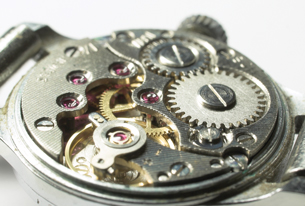Module 7—Oscillatory Motion
Lesson 3—Mechanical Resonance
 Get Focused
Get Focused

© Kirill Volkov/shutterstock
The modern wristwatch has come a long way in a relatively short time. In 1969, Seiko produced the world’s first quartz wristwatch. Because it kept excellent time, something in the watch had to oscillate with a constant frequency. Recall that in a pendulum clock, the period of the pendulum was constant and it was used to control a set of gears that turned the hour and minute hands with constant frequency. In a similar way, the wristwatch needs an oscillator with a constant period. So, what do you put into a wristwatch that is tiny, oscillates with a constant frequency, and is unaffected by acceleration and movement? A precisely cut 3-mm quartz crystal “resonator” is perfect for the job! The next obvious question is, “Why?”
piezoelectricity: the ability of certain crystals to change shape when a voltage is applied across them or to produce a voltage when a force is applied to them
resonant frequency: the frequency at which a system naturally vibrates
Chemically speaking, quartz is silicon dioxide. When it is cut in a specific shape and mounted correctly, it will bend in an electric field. When the electric field is removed, it will bend back, generating its own electric field and causing the motion to repeat. This relationship between deformation and electric fields is common in crystals and is called piezoelectricity. With the right shape and applied voltage, a quartz crystal will oscillate (bend back and forth) exactly 32 768 times per second for as long as the voltage is present. This constant, known frequency makes it ideal for driving the electric circuit of a modern wristwatch. This simple resonant frequency keeps everyone on the same time schedule, but it only works when the crystal is cut in a very precise shape. Why? What is a resonant frequency, and what is its relationship to the physical shape of an object? Do other, larger objects, such as bridges and buildings, oscillate with a precise frequency when disturbed?
In this lesson you will investigate the following questions:
- What is a resonant frequency?
- What is mechanical resonance?
- Are there examples of mechanical resonance in your everyday world?
 Module 7: Lesson 3 Assignments
Module 7: Lesson 3 Assignments
Your teacher-marked Module 7: Lesson 3 Assignment requires you to submit a response to the following:
- Try This—TR 1, TR 2, TR 3, TR 4, TR 5, TR 6, and TR 7
- Lab—LAB 1 and LAB 2
You must decide what to do with the questions that are not marked by the teacher.
Remember that these questions provide you with the practice and feedback that you need to successfully complete this course. You should respond to all the questions and place those answers in your course folder.